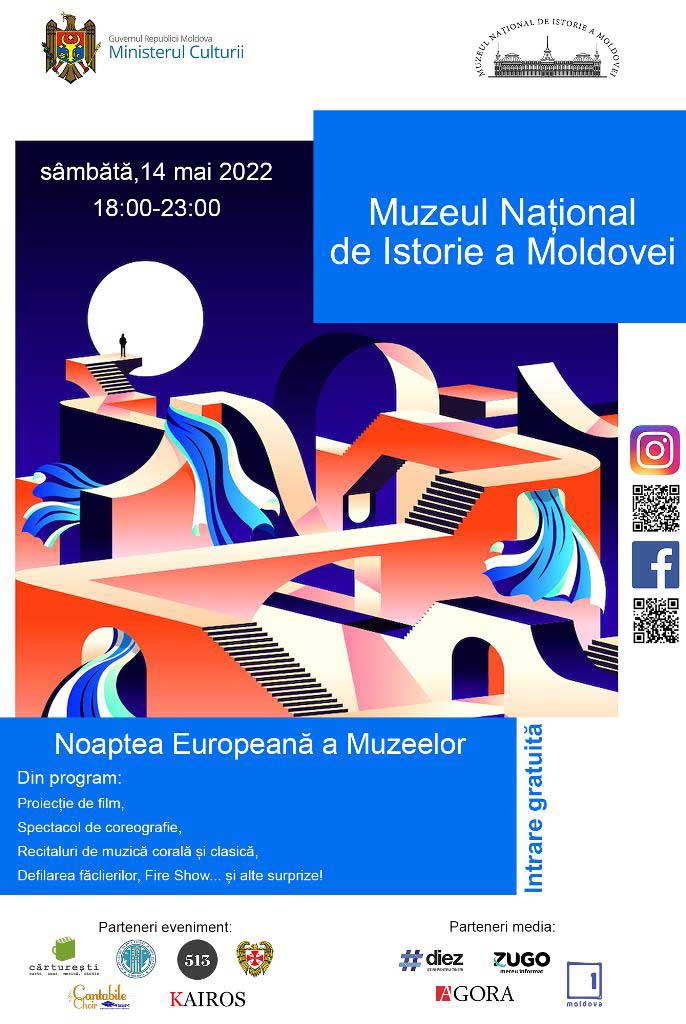  Events Archive Events Archive
The European Night of Museums 2022
„The light gives splendor to the night…” May 14, 2022
 On Saturday, May 14, 2022, from 18:00 to 23:00, at the National Museum of History of Moldova, one of the most important events in the life of the world museum community took place - the European Night of Museums, which this year was held under the motto "The light gives splendor to the night...". This is the 18th edition of the event initiated by the French Ministry of Culture, which is currently under the patronage of UNESCO, the Council of Europe and the International Council of Museums (ICOM). On Saturday, May 14, 2022, from 18:00 to 23:00, at the National Museum of History of Moldova, one of the most important events in the life of the world museum community took place - the European Night of Museums, which this year was held under the motto "The light gives splendor to the night...". This is the 18th edition of the event initiated by the French Ministry of Culture, which is currently under the patronage of UNESCO, the Council of Europe and the International Council of Museums (ICOM).
The National Museum of the History of Moldova, in cooperation with our partners, has prepared a rich and full of surprises program for visitors. The evening began with a choreographic show "Dancing on the Edge of Time" performed by students of the Faculty of Choreographic Art of the Academy of Music, Theater and Fine Arts, coordinated by Snejana Apostol. During the evening, three more dance shows were presented in different rooms of the museum, which were meant to invite visitors to learn history through dance, so that "through the dance the history becomes visible". That night, the Blue Room of the museum became the temple of the "Music for Peace". The divine voices of the girls from the "Cantabile" choir of the Academy of Economic Studies of Moldova, under the direction of Elena Marian, accompanist Vitalie Mosiiciuc, sounded in a wonderful concert of choral music.
A balm for the soul was the concert of classical music "Discover Classical Music in the Museum" performed by the members of the musical and literary salon "Vine and Lyra". Extraordinary voices of soloists Nicolae Busuioc, People's Artist of the Republic of Moldova; Angela Apti, Honored Artist of the Republic of Moldova, soloist of the Maria Bieșu National Opera and Ballet Theatre; Alexei Digore, soloist of the Maria Bieșu National Opera and Ballet Theatre; Tatiana Gavrilița, laureate of republican and international vocal competitions, brought light, emotions and grandiose resonance to this magical evening at the museum.
The museum courtyard was the place where visitors enjoyed the screening of the film "From the museum's collections", sat on the grass, admired the exhibits and the reconstruction of the Cucuteni culture dwelling, took pictures against the backdrop of the beautifully lit museum building.
During the evening, Cărturești in the Museum offered a series of authors' recitals, with the title "Literary Ambiences", where they highlighted the museum's heritage and perpetuated the light through decorations and books.
At the same time, Tucano Coffee Moldova prepared an extremely interesting quest for history lovers and offered many surprises and prizes.
The evening culminated with the parade of torchbearers, a unique show of medieval fighting, organized by the Ensifer Historical Club under the direction of Mikhail Tereshchenko, and the fire show by the Kairos Club under the direction of Elena Trukhina.
The Night of Museums is over, but the emotions are still there! We are very glad that on the Night of Museums we saw in our rooms a huge number of beautiful and friendly people, lovers of history and beauty, who opened their souls to this event.
We sincerely thank the staff of the National Museum of History of Moldova, who was involved in the event, ensuring its smooth running, as well as our guests and partners.
Event Partners: Cărturești in the Museum; 513; Cantabile Youth Choir of the Academy of Economic Studies of Moldova; Faculty of Choreographic Art of the Academy of Music, Theater and Fine Arts; Vine and Lyra Musical and Literary Salon, Ensifer Historical Club; Kairos Club.
Media Partners: Agora.md; ZUGO; diez.md; TV Moldova1.
|


















.JPG)
.JPG)












































